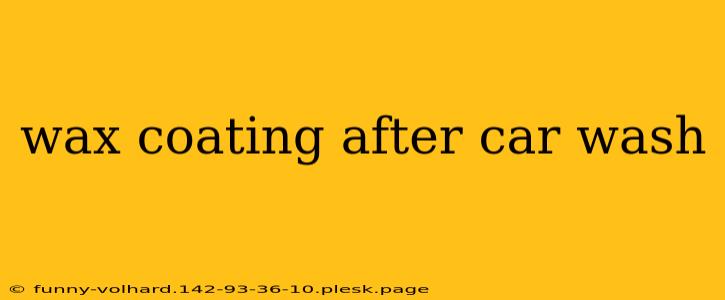Washing your car is only half the battle in achieving that showroom-worthy gleam. A proper wax coating after your car wash is the secret weapon for long-lasting protection and an unparalleled shine. This comprehensive guide will walk you through the process, highlighting best practices and answering frequently asked questions to help you achieve the best results.
Why Wax After Washing Your Car?
Washing your car removes dirt, grime, and other contaminants. However, it doesn't provide lasting protection against the elements. This is where waxing comes in. A wax coating acts as a protective barrier, shielding your car's paint from:
- UV rays: Sunlight can fade your car's paint over time. Wax helps to prevent this by reflecting UV rays.
- Acid rain: Acid rain is highly corrosive and can damage your car's finish. Wax creates a barrier that helps to neutralize its effects.
- Bird droppings: Bird droppings are highly acidic and can etch into your paint if left on for too long. Wax makes it easier to remove them and prevents damage.
- Scratches and swirl marks: While not entirely preventing them, a wax coating can minimize the appearance of minor scratches and swirl marks, enhancing the overall gloss.
Choosing the Right Wax: Types and Considerations
The market offers a vast array of car waxes, each with its own characteristics and benefits. Here are some popular types:
1. Carnauba Wax:
- Pros: Natural, deep shine, excellent protection.
- Cons: Can be more expensive, requires more frequent applications.
2. Synthetic Wax:
- Pros: Durable, easy to apply, often more affordable.
- Cons: May not offer the same depth of shine as carnauba wax.
3. Hybrid Wax:
- Pros: Combines the benefits of both carnauba and synthetic waxes, offering a balance of shine, durability, and ease of application.
- Cons: Generally more expensive than synthetic wax.
Consider these factors when selecting a wax:
- Your budget: Waxes range in price significantly.
- Your desired level of shine: Carnauba wax generally provides a deeper shine.
- Your desired level of durability: Synthetic waxes often last longer.
- Ease of application: Some waxes are easier to apply and buff than others.
The Step-by-Step Guide to Waxing Your Car After Washing
After you've thoroughly washed and dried your car, follow these steps for optimal results:
- Prepare the surface: Ensure your car is completely dry and free of any remaining dirt or debris. Use a detailing clay bar if necessary to remove embedded contaminants.
- Apply the wax: Apply a thin, even layer of wax using an applicator pad, working in small sections.
- Allow it to dry: Let the wax dry according to the manufacturer's instructions. This usually takes several minutes.
- Buff the wax: Use a clean microfiber towel to buff the wax off, working in small, circular motions. Apply gentle pressure to avoid scratching the paint.
- Inspect your work: Check for any missed spots or streaks. Re-apply wax if necessary.
Maintaining Your Wax Coating
To maximize the longevity of your wax coating, avoid washing your car too frequently and always use a gentle car wash soap. Consider using a quick detailer spray between washes to remove light dirt and dust. Regular waxing, every few months, will help to maintain that showroom shine and protective barrier.
Frequently Asked Questions (FAQs)
Q: How often should I wax my car?
A: Ideally, you should wax your car every 2-3 months, or more frequently if you live in a harsh climate or park your car outdoors regularly.
Q: Can I wax my car in direct sunlight?
A: No, avoid waxing your car in direct sunlight as the wax can dry too quickly, making it difficult to buff off and potentially leaving streaks.
By following these tips and techniques, you can achieve a stunning, protected finish that will make your car the envy of the neighborhood. Remember, a proper wax coating after your car wash is an essential step in maintaining your vehicle's beauty and longevity.

